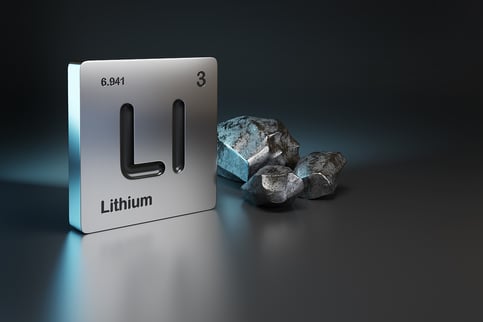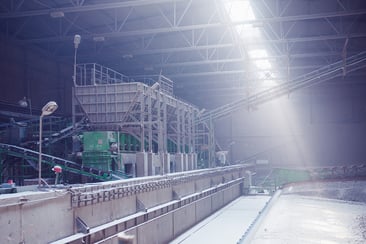Dust is a concern in every industry, yet dust characteristics and industry needs differ, dictating varying approaches to its collection. Effective industrial dust removal improves plant safety, assists with plant maintenance, improves air quality and decreases potential health hazards.
Lithium processing produces its share of dust, characterized by its high reactivity and combustibility. When milled to the micron level required during battery production, for example, it is exceptionally light, reactive to moisture and prone to become airborne.
Lithium is a metal, although the least dense. It also is highly reactive to its surrounding environment. This reactivity is one factor that makes lithium an ingredient of choice within batteries.
The lion’s share of processed lithium is destined for use in batteries that power electronics, electric vehicles, or store energy in the grid. Rechargeable lithium batteries for these purposes account for 74% of global lithium demand. A recent industry analysis predicted that the lithium-ion battery market will grow at a CAGR of 30% through 2030, making it a lucrative industry for the foreseeable future. This growth considers the entire battery cycle, from mining to recycling. 
Lithium dust collection is an industry necessity
Many steps, from ore or brine to battery components, can produce lithium dust. Its collection is vital for numerous reasons, including the potential recycling of a valuable resource back into the manufacturing process. Some of the stages that can produce lithium dust include:
-
Mining: When mining lithium from hard rock, the blasting and drilling can create dust. In the case of brine extraction, evaporation ponds also can produce lithium dust as the water disappears and the lithium concentration increases.
-
Crushing: Once lithium-bearing ores are extracted, they often are crushed and milled to reduce the rock size. This process creates dust as the ore is broken into smaller pieces.
-
Milling or grinding: A mill or grinding equipment takes the lithium and processes it to achieve a final, specific size. Milling equipment can size down the lithium to five microns or less dust particles.
-
Drying and packaging: Brining leaves behind a slurry of ever more concentrated lithium as the water evaporates, and this slurry requires drying to reduce the moisture yet further. During the drying and packaging process, this light material requires collection to protect workers and the environment and to recapture a precious resource.
What types of dust collection equipment are used in lithium processing?
A few types of dust collection systems can help with lithium dust collection. These can include cyclones, baghouses and loading spouts.
A cyclone is a dust collection system that uses centrifugal force to separate particles from a gas stream. As the gas enters the cyclone through an inlet, it spins rapidly around the inside of the cylinder. The centrifugal force of this movement forces the heavier particles to be thrown outward toward the cylinder walls. The particles slide down the walls for collection at the bottom of the cyclone.
The remaining cleaned gas stream can go through additional filters or be returned to the environment. A cyclone is a standard dust collection system used for mining operations or when lithium is rough cut.
In a baghouse system, the air containing dust is drawn through the bags, which trap or collect the dust on their surface or inside fabric filters. Clean air returns to the work environment, and the captured dust is collected for disposal or recycling into the process stream. Baghouses feature prominently as dust collection systems for lithium dust, so we will explore that a bit more, below.
A loading spout helps contain the dust as it is discharged into a container or transportation to the next stage of its processing journey, such as a truck or rail car.
The process of lithium dust collection using a baghouse
Lithium processing typically involves the handling of fine powders and particles that can become airborne and pose a health hazard or safety risk.
 The contaminated air containing dust particles is drawn into the dust collector through its inlet. Dust particle variables dictate the placement of the inlet on the baghouse. Sly LLC has a staff of design engineers that work closely with clients to modify baghouse features for optimal efficiencies, such as inlet placement and filter media selection.
The contaminated air containing dust particles is drawn into the dust collector through its inlet. Dust particle variables dictate the placement of the inlet on the baghouse. Sly LLC has a staff of design engineers that work closely with clients to modify baghouse features for optimal efficiencies, such as inlet placement and filter media selection.
The air passes through a series of filters, which capture and trap the dust particles. The type of filter used will depend on the size and characteristics of the dust particle being collected.
The filtered air is discharged from the dust collector through an outlet.
As the dust particles accumulate on the filters, a timed system causes the dust particles to release and fall to the bottom for collection. Filter media selection can enhance dust cake release, with filter selection related to dust characteristics and moisture or humidity levels.
The dust either falls into a bin or hopper for disposal or passes onto a conveyor for reentry into the processing stream.
Dust collectors often are equipped with additional features, such as explosion vents or fire suppression systems, to reduce the risk of fires or explosions caused by the presence of potentially combustible dust particles.
Looking for a partner to help select the right equipment for lithium dust collection? Sly LLC has worked with customers in the lithium processing industry for over twenty years, backed up by a company history that spans more than 100 years in the dust collection industry. Call Sly LLC today or download our recent white paper on lithium processing and dust collection by clicking here. http://info.slyinc.com/lithium-wp
Author: Dave Mosinski, Regional Sales Manager
Dave has been in the dust collection industry and with Sly for over 26 years.



